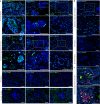An organ-derived extracellular matrix triggers in situ kidney regeneration in a preclinical model
- PMID: 35228532
- PMCID: PMC8885654
- DOI: 10.1038/s41536-022-00213-y
An organ-derived extracellular matrix triggers in situ kidney regeneration in a preclinical model
Abstract
It has not been considered that nephrons regenerate in adult mammals. We present that an organ-derived extracellular matrix in situ induces nephron regeneration in a preclinical model. A porcine kidney-derived extracellular matrix was sutured onto the surface of partial nephrectomy (PN)-treated kidney. Twenty-eight days after implantation, glomeruli, vessels, and renal tubules, characteristic of nephrons, were histologically observed within the matrix. No fibrillogenesis was observed in the matrix nor the matrix-sutured kidney, although this occurred in a PN kidney without the matrix, indicating the structures were newly induced by the matrix. The expression of renal progenitor markers, including Sall1, Six2, and WT-1, within the matrix supported the induction of nephron regeneration by the matrix. Furthermore, active blood flow was observed inside the matrix using computed tomography. The matrix provides structural and functional foundations for the development of cell-free scaffolds with a remarkably low risk of immune rejection and cancerization.
© 2022. The Author(s).
Conflict of interest statement
The authors declare no competing interests.
Figures






Similar articles
-
Sall1 maintains nephron progenitors and nascent nephrons by acting as both an activator and a repressor.J Am Soc Nephrol. 2014 Nov;25(11):2584-95. doi: 10.1681/ASN.2013080896. Epub 2014 Apr 17. J Am Soc Nephrol. 2014. PMID: 24744442 Free PMC article.
-
Nephron organoids derived from human pluripotent stem cells model kidney development and injury.Nat Biotechnol. 2015 Nov;33(11):1193-200. doi: 10.1038/nbt.3392. Nat Biotechnol. 2015. PMID: 26458176 Free PMC article.
-
Preserved Nephrogenesis Following Partial Nephrectomy in Early Neonates.Sci Rep. 2016 May 31;6:26792. doi: 10.1038/srep26792. Sci Rep. 2016. PMID: 27244673 Free PMC article.
-
Induction of nephron progenitors and glomeruli from human pluripotent stem cells.Pediatr Nephrol. 2017 Feb;32(2):195-200. doi: 10.1007/s00467-016-3339-z. Epub 2016 Feb 11. Pediatr Nephrol. 2017. PMID: 26868670 Review.
-
Regenerating the nephron with human pluripotent stem cells.Curr Opin Organ Transplant. 2015 Apr;20(2):187-92. doi: 10.1097/MOT.0000000000000177. Curr Opin Organ Transplant. 2015. PMID: 25695593 Review.
Cited by
-
Current status and future prospects of decellularized kidney tissue.J Artif Organs. 2023 Sep;26(3):171-175. doi: 10.1007/s10047-022-01366-9. Epub 2022 Sep 22. J Artif Organs. 2023. PMID: 36138180 Review.
-
Analysis of research trends and hotspots in the primary treatment of end-stage renal disease.Int Urol Nephrol. 2025 May;57(5):1513-1531. doi: 10.1007/s11255-024-04290-4. Epub 2024 Nov 26. Int Urol Nephrol. 2025. PMID: 39589637 Review.
-
Histological effects of combined therapy involving scar resection, decellularized scaffolds, and human iPSC-NS/PCs transplantation in chronic complete spinal cord injury.Sci Rep. 2024 Dec 28;14(1):31500. doi: 10.1038/s41598-024-82959-7. Sci Rep. 2024. PMID: 39733145 Free PMC article.
-
Incorporating Bone-Derived ECM into Macroporous Microribbon Scaffolds Accelerates Bone Regeneration.Adv Healthc Mater. 2025 Mar;14(6):e2402138. doi: 10.1002/adhm.202402138. Epub 2025 Jan 31. Adv Healthc Mater. 2025. PMID: 39891301
-
Extracellular matrix-derived materials for tissue engineering and regenerative medicine: A journey from isolation to characterization and application.Bioact Mater. 2024 Jan 17;34:494-519. doi: 10.1016/j.bioactmat.2024.01.004. eCollection 2024 Apr. Bioact Mater. 2024. PMID: 38298755 Free PMC article. Review.
References
-
- Bertram JF, Douglas-Denton RN, Diouf B, Hughson MD, Hoy WE. Human nephron number: implications for health and disease. Pediatr. Nephrol. 2011;26:1529–1533. - PubMed
-
- Keller G, Zimmer G, Mall G, Ritz E, Amann K. Nephron number in patients with primary hypertension. N. Engl. J. Med. 2003;348:101–108. - PubMed
-
- Saxen L, Sariola H. Early organogenesis of the kidney. Pediatr. Nephrol. 1987;1:385–392. - PubMed
-
- Jha V, et al. Chronic kidney disease: global dimension and perspectives. Lancet. 2013;382:260–272. - PubMed
Grants and funding
LinkOut - more resources
Full Text Sources

